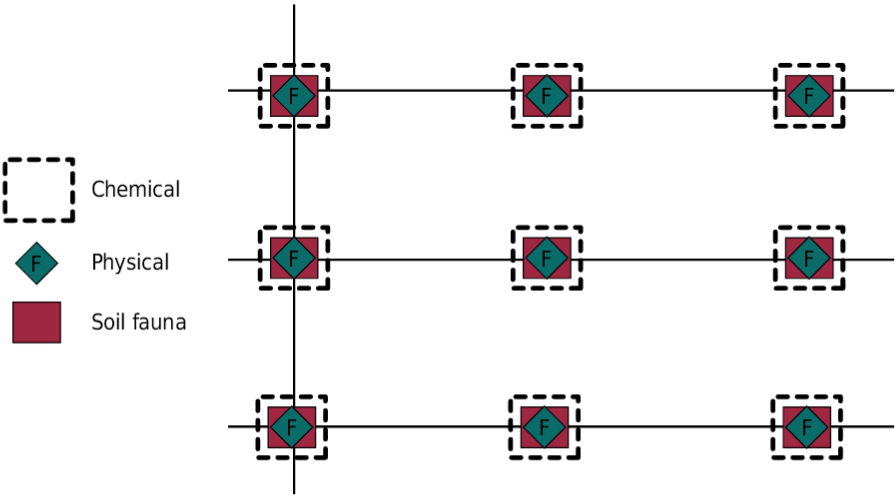Figure 1
Sampling grid used in the collection of samples for chemical and physical analysis and quantification of soil macrofauna.
Figure 2
Richness of soil macrofaunal groups in the land use systems: native forest (NF), eucalyptus plantations (EP), perennial pasture (PP), integrated crop-livestock (ICL), and no-tillage (NT) in the summer (a) and winter (b), in the eastern region of Santa Catarina, Brazil. Different letters above the bars reflect statistical difference using the t test (p<0.05) and line bars are standard deviation.
Figure 3
Abundance of soil macrofaunal groups in the land use systems: native forest (NF), eucalyptus plantations (EP), perennial pasture (PP), integrated crop-livestock (ICL), and no-tillage (NT), in the summer (a) and winter (b), in the eastern region of Santa Catarina, Brazil. Different letters above the bars reflect statistical difference using the t test (p<0.05) and line bars are standard deviation.
Figure 4
Shannon diversity index in box-plots for the land use systems: native forest (NF), eucalyptus plantations (EP), perennial pasture (PP), integrated crop-livestock (ICL), and no-tillage (NT) in the summer (a) and winter (b), in the eastern region of Santa Catarina, Brazil.
Figure 5
Principal component analysis (PCA) to differentiate native forest (NF), eucalyptus plantations (EP), perennial pasture (PP), integrated crop-livestock (ICL), and no-tillage systems (NT) based on samples collected in the summer, in the eastern region of Santa Catarina, Brazil. Vectors in bold represent the soil physical (BD: bulk density, Macro: macroporosity) and chemical properties (Ca: calcium, K: potassium, P: phosphorus, Bases: base saturation, OM: organic matter). In italics are the main macrofaunal groups: Oligochaeta (Olig), Opiliones (Opi), Formicidae (Form), Amphipoda (Amphi), Coleoptera (Coleop), total of other larvae (Larv), Molusca (Mol), Diplopoda (Dipl), Chilopoda (Chil), Isopoda (Isopo), Araneae (Ara), Isoptera (Isopt), Orthoptera (Orth), Hemiptera (Hemip), Dermaptera (Derm), Pseudoscorpionidae (Pseu), Diplura (Diplu), and total of other less frequent groups (Oth).
Figure 6
Principal component analysis (PCA) to differentiate native forest (NF), eucalypt plantations (EP), perennial pasture (PP), integrated crop-livestock system (ICL), and no-tillage (NT) based on samples collected in the winter, in the eastern region of Santa Catarina, Brazil. Vectors in bold represent the soil physical (BD: bulk density) and chemical properties (Mg: magnesium, P: phosphorus, H+Al: potential acidity, base saturation (Bases). In italics are the main macrofaunal groups: Oligochaeta (Olig), Opiliones (Opi), Formicidae (Form), Coleoptera (Coleop), total of other larvae (Larv), Molusca (Mol), Diplopoda (Dipl), Chilopoda (Chil), Isopoda (Isopo), Araneae (Ara), Amphipoda (Amphi), Isoptera (Isopt), Orthoptera (Orth), Hemiptera (Hemip), Dermaptera (Derm), Diptera (Dipt), and total of other less frequent groups (Oth).
Figure 7
Redundancy analysis (RDA) for macrofaunal groups (in italics) and soil physical and chemical properties (in bold) in the summer sampling in the eastern region of Santa Catarina, Brazil. Oligochaeta (Olig), Formicidae (Form), Coleoptera (Coleop), Opiliones (Opi), Dermaptera (Derm), total of other larvae (Larv), Molusca (Mol), Pseudoscorpionidae (Pseu), Diplopoda (Dipl), Chilopoda (Chil), Isopoda (Isopo), Araneae (Ara), Blattodea (Blat), Diplura (Diplu), Isoptera (Isopt), Orthoptera (Orth), Amphipoda (Amphi), total of other less frequent groups (Oth). Chemical properties: phosphorus (P), calcium (Ca), potassium (K), base saturation (Bases), organic matter (OM), and physical properties: macroporosity (Macro) and bulk density (BD).
Figure 8
Redundancy analysis (RDA) for macrofaunal groups (in italics) and soil physical and chemical properties (in bold) in the winter sampling in the eastern region of Santa Catarina, Brazil. Oligochaeta (Olig), Formicidae (Form), Coleoptera (Coleop), Opiliones (Opi), Dermaptera (Derm), total of other larvae (Larv), Molusca (Mol), Pseudoscorpionidae (Pseu), Diplopoda (Dipl), Chilopoda (Chil), Isopoda (Isopo), Araneae (Ara), Blattodea (Blat), Isoptera (Isopt), Orthoptera (Orth), Amphipoda (Amph), Hemiptera (Hemip), Diptera (Dipt), and total of other less frequent groups (Oth). Chemical properties: phosphorus (P), magnesium (Mg), base saturation (Bases), potential acidity (H+Al), and physical properties: bulk density (BD).








